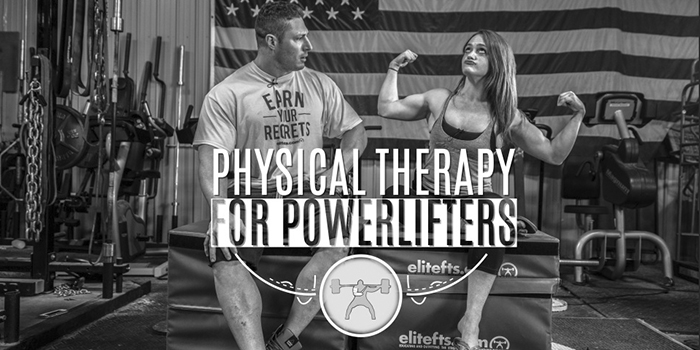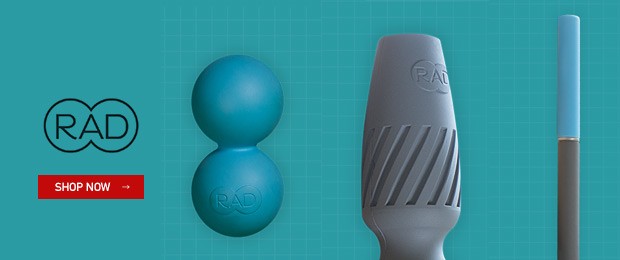
We talk about glutes all the time, but we don’t fully appreciate their role in tri-planar motion, not only in stabilizing a pelvis but also in what happens to that glute on an asymmetrical pelvis. A glute is a hip extensor, yes, but in a wide stance squatter like Casey who lives in a bit of external rotation and abduction, the glutes also need to take on a role in that plane (e.g. they need to be able to function in that role!). We pulled him into his left hip in the previous exercise, while this next correction is designed to help drive him “off” his right hip. This is one building block to where I wanted to take him next. This position works well because we can target the right glute and left core (similar to previous exercises) without putting his glute in a position that demands more than its ability. That step will come next. We build from the ground up first.
WATCH: Anterior Pelvic Tilt Fix with Casey Williams and Dani Overcash — Creating an Anchor Point
Casey talked a lot about patience with this one, and he couldn’t be more right. Here’s the thing: Muscles have a certain line of pull that determines their mechanical advantage. On an asymmetrical pelvis the way Casey’s was, certain parts or divisions of his glute became inhibited partially based on mechanics and partially based on neural mechanisms that, truthfully, I’m still working through. If the base that a system of levers/pulleys is attached to changes position, certain pulley systems will work better, while others won’t work as well. So the 90-90 hip lift was one component of repositioning the pelvis, and as we re-habituated him back to neutral, his glute was in a better position (think mechanical advantage) to function as desired.
Yes, glute for hip extension. But Casey’s problem was that he was constantly “in” his right side. In this case, we needed to utilize it to get him to drive off his right side.
I hope you’re seeing how some of these pieces are coming together:
- Reposition pelvis to neutral.
- Get him into his left hip.
- Get him off of his right side.
This all addressed why he had dysfunction while he took time away from the bar to let tissue heal. We concurrently did other rehab and patterning drills outside of the PRI foundations that included glute retraining with pelvis neutral.
A few keys from the exercise:
Patience, patience, patience. I will tell you firsthand that when I am strong in this particular asymmetry, it's like I feel small parts of my glute if at all. It just means your body’s set point or home base isn’t quite stabilized to neutral yet, and you may or may not be ready for this progression. No big deal — just needs a little time. The changes we incur on a small, neurological level yield tremendous benefits in movement and in training. You’re going to have to be subtle with this; think small contractions and quiet muscles.
I'll come back to the analogy of the volume switch: You’re not trying to turn the volume to maximum with this, but just enough that you can hear what you’re intended to. In this case, it’s the right glute with a little bit of left oblique. Use a towel under your abs if you need to in order to keep your back shut off. Do not compromise that.
Your hips should roll forward just a little to incur pelvic rotation, but this should be very subtle. As you reach, your back may start to arch. As you lift your knee, it may start to arch. This is indicative of your back turning “on.” Remember, not worth the compromise. I tell patients every day that they are only permitted to progress through this exercise so far as they can maintain position. Position is everything in this particular circumstance.
There are a few things to address with day-to-day-variability. In this video, Casey is talking about small changes in position. As you correct from an asymmetrical pattern to a more neutral one, it’s not going to be a black or white. You’re going to exist somewhere on the spectrum, and based on the principles of advantage and the neural stuff I'm still teasing through, position will dictate what works. Where you are on that neutral/asymmetrical spectrum will vary day-to-day, accounting for the variability in perceived muscle engagement. You should, however, feel consistency improve. If it is not improving, you are probably progressing too quickly. Go back to the 90-90 hip lift and get really, REALLY good at it. I mean perfect. Most people I see day-to-day correct well with just this. Casey’s strong enough and adapted enough that he needed a little extra to get out. You may not.
This brings me to the next point: How strong you are in the pattern (again, where you fall on the asymmetrical/neutral spectrum) will play a role in how effectively you can find a glute in this position. This is different than straight hip extension; it’s the alternate of the asymmetry you are in. It should be difficult because it's your reciprocal. It may require a few weeks of doing the first two exercises before you're even ready for this one.
Perhaps most important: Again, note how relaxed Casey is. He’s not really straining. He can feel what he needs to but overall looks relatively relaxed. If you ask him, he’ll probably tell you that was not always the case. The next exercise will take this up a notch and continue to translate to his squat.
Please keep in mind, these articles offer one possible solution, which has worked for Casey. Generally, this combination of exercises is a great bread-and-butter for addressing the hip shift many of us have, but it requires consistency and time, generally a few weeks. What occurs in that time, however, yields incredible results in overall health, as well as performance.
Pro Tips from Casey
- Neutral — You need to get your body to feel comfortable in the neutral position. I may never get there, but now I’m always cognizant of it, so much so that I practice it in the shower every night because it still takes effort for me to get to and hold that position.
- Left Oblique — As we stressed, it’s a light squeeze. Same as your hamstrings in the 90-90 hip lift, you just want to know that it’s turned on. It doesn’t need to be doing any real "work."
- Right Knee — Push it forward, almost like you’re pushing it out of socket. It’s not in any way a natural feeling, but it’s really important that you do not rotate or roll your hips forward to get that knee forward. It’s better to get your knee pushed forward one inch forward while staying square than it is six inches with even a slight rotation.
- Right Knee Lift — Shorten the range of motion to keep that knee forward. Proper engagement through a shorter ROM will help create that anchor point and help your mind connect to that position, making it easier to get to in a squat.
- The Feels — You want to feel this in your glute. For the first month or two that I did these I would typically get that tightness/tension in the hip which is what you want to avoid. You want that glute to activate and become another anchor point for your hip.
- Reset — If you’re not getting the activation that you’re supposed to, reset. Take a deep breath. Try again slowly and patiently.
Continue watching this seven-part weekly series for exercises that helped mediate Casey's hip shift and dysfunction.









